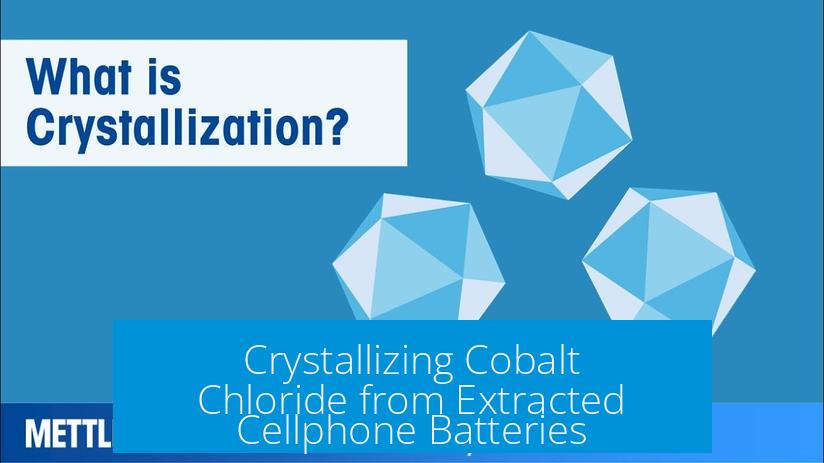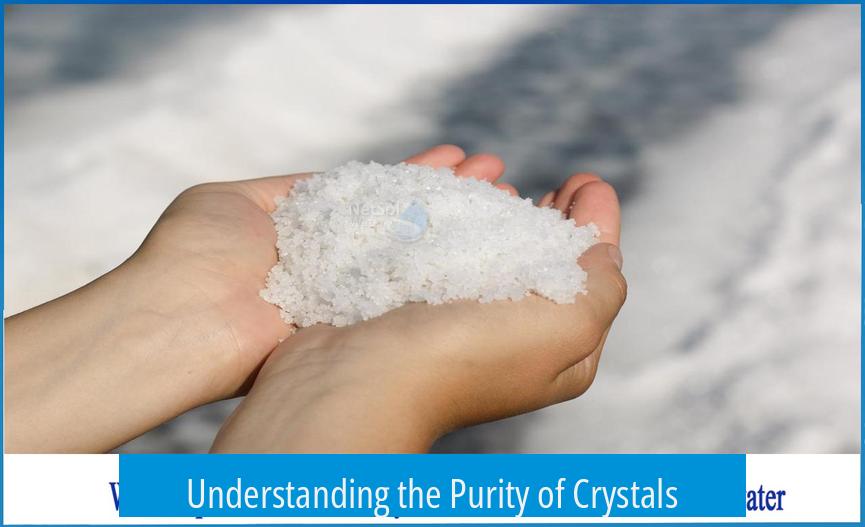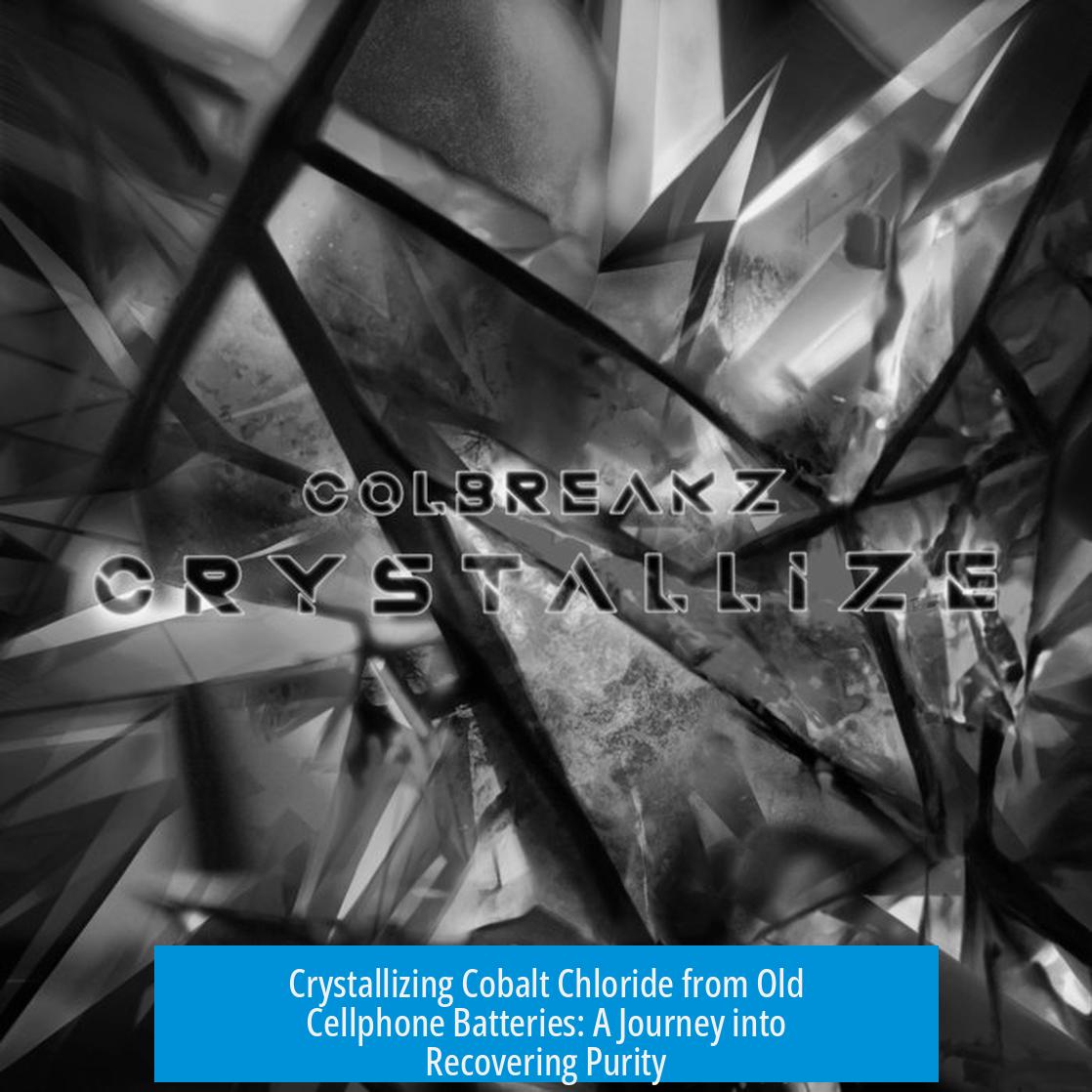Crystallizing Cobalt Chloride from Extracted Cellphone Batteries

Successfully crystallizing cobalt chloride from old cellphone batteries indicates a degree of purity despite initial assumptions of high impurity. When well-formed crystals appear, it generally suggests the compound has been purified enough through crystallization.
Understanding the Purity of Crystals

While the extracted cobalt chloride may start impure due to battery materials, crystallization helps isolate the compound in a more refined form. Sharp, defined crystals usually reflect a relatively pure sample. Impurities often disrupt crystal formation, resulting in less structured or powdery residue.
Thus, seeing distinct cobalt chloride crystals is a good sign. However, residual battery contaminants or inadequate purification steps can still leave compounds mixed with the crystals.
Extraction Method and Setup

The cobalt chloride in this scenario comes from dismantling several cellphone batteries. The process typically involves dissolving battery components, followed by filtration and evaporation to encourage crystal growth.
- Dismantling carefully to isolate cobalt-containing parts
- Dissolving materials in acid or water to extract cobalt ions
- Filtering to remove solids and precipitates
- Allowing slow evaporation to form cobalt chloride crystals
Improvisation using household items like a Gatorade bottle is common, although laboratory glassware improves safety and results.
Safety and Handling

Cobalt chloride poses health risks and requires careful handling. It is classified as hazardous by the Globally Harmonized System (GHS). Wearing gloves, using well-ventilated areas, and avoiding direct skin contact is crucial.
Extracting chemicals from batteries can also release toxic substances or cause fires if mishandled. Performing such experiments in a proper lab environment or under supervision ensures safety.
Appreciating Crystal Growth

The formation of vibrant, visible cobalt chloride crystals often excites chemists and hobbyists alike. The crystals sometimes appear deep blue or purple due to hydration levels.
Crystallization offers insight into the chemical’s properties and confirms its presence. It also helps separate cobalt chloride from the many impurities originally present in battery waste.
Summary of Key Points

- Clear crystals usually indicate reasonable purity despite starting impurities.
- Extraction involves dissolving, filtering, and evaporating cobalt-containing battery parts.
- Handling cobalt chloride requires strict safety measures due to toxicity.
- Crystallization confirms compound identity and purifies the sample.
- Using proper lab equipment enhances both safety and crystal quality.
Was Able to Crystalize Some (Probably Highly Impure) Cobalt Chloride I Extracted from a Few Old Cellphone Batteries
Can you really get nice cobalt chloride crystals from old cellphone batteries? Absolutely, yes! Even though the crystals might seem ‘highly impure’ at first glance, the fact that crystals form at all suggests a surprising level of purity. How is that possible? Let’s unravel this curious chemical tale, step by step.
Extracting cobalt chloride from scraps like cellphone batteries might sound like mad scientist territory. Yet, it’s a fun experiment to try if you enjoy turning tech trash into colorful crystals. Let’s look at the story behind those cobalt chloride crystals, weighing the reality versus expectations.
Turning Old Cellphone Batteries into Crystal Treasure
The story starts with chemistry enthusiast neighbors and a few old phone batteries tossed aside. These batteries contain cobalt compounds, albeit mixed with various metals and contaminants. Extracting the cobalt chloride involves breaking down the battery components — not for the faint of heart or the untrained! Notably, one neighbor uses a Gatorade bottle, and occasionally, there’s an explosive result. Luckily, our crystal-crazed friend did better and ended up with actual crystals rather than fireworks!
Old batteries have many impurities and other metals like lithium, nickel, and manganese. Extracting cobalt chloride from this mélange requires careful chemical steps: dissolving, filtering, and evaporating solutions to encourage crystal growth. While the source material is dirty, the crystallization process itself can be a natural purifier. Impurities usually disrupt crystal formation, so a well-formed crystal tends to be fairly pure. That’s why crystallizing cobalt chloride can serve as a simple purification step.
How Pure Are These Crystals?
Some say, “if it crystals nicely, it’s not as impure as you think.” Chemists will nod at this. Why? Crystal growth favors pure chemical structures. The impurities tend to remain in the solution or cause defects rather than forming neat crystals.
Yet, don’t imagine battery-sourced crystals rival pharmaceutical-grade chemicals just yet! They can be contaminated, depending on extraction effectiveness and purity of reagents used. But even ‘impure’ crystals can be vibrant and chemically interesting. Consider the iconic cobalt chloride color shifts — transitioning from blue when dry to pink when hydrated. Seeing that happen is rewarding.
So, if you find neat blue or purple crystals from your battery dump, pat yourself on the back. You got more purity than you bargained for!
Safety First: Handle With Care
Before anyone rushes to grab old batteries and chemistry sets, let’s get real about safety. Cobalt chloride isn’t just a pretty pigment; it’s hazardous. According to the Globally Harmonized System (GHS), cobalt chloride is toxic and potentially carcinogenic. It can irritate skin, eyes, and respiratory systems.
If you’re trying this at home, be sure to wear gloves, goggles, and work in a well-ventilated area. Better yet, do it in a proper lab environment with safety protocols. The experiment’s allure might tempt curiosity, but cobalt compounds demand respect. Avoid inhaling powders or fumes and dispose of leftover chemicals responsibly.
Curious About the Extraction Procedure?
Many ask, “Link for the procedure? Please!” Well, the extraction involves collecting cobalt-containing battery parts, dissolving them in an acid (commonly hydrochloric acid), filtering out solids, and evaporating the solution slowly. Patience is key. Crystals typically form as water evaporates and the cobalt chloride reaches supersaturation.
Repeating the filtering or recrystallization at times purifies the substance further. Evaporation rate influences crystal size and clarity — slow wins the race here. Of course, meticulous lab work beats haphazard experiments in Gatorade bottles, but the DIY spirit is commendable!
Admiring the Crystal Harvest
What exactly did those crystals look like? Many compare them to “forbidden rock candy.” Imagine deep red to purplish crystals sparkling – nature’s own geology plus a touch of chemistry magic. Observers online celebrate these as “damn, those are some beautiful crystals!” or “that’s dope!” If you were wondering, cobalt chloride crystals are amazing visual indicators often used in humidity sensors because of their striking color shifts.
Some folks jokingly ask, “In English, someone tell me what it is? #CommonFoke.” Simply put, these are the shiny results of old battery salvage turned chemistry showcase. They remind us how everyday objects can surprise us with hidden science stories.
Practical Tips for Your Crystal Quest
- Choose the right batteries: Older lithium-ion cellphone batteries contain cobalt, but composition varies. Avoid damaged or swollen batteries for safety.
- Work slow: Rushing evaporation or filtering can produce messy results. Patience leads to better crystals.
- Ensure safety gear: Gloves, goggles, and ventilation are non-negotiable.
- Document your process: Tracking steps helps improve the experiment and diagnose issues like impurity or unexpected reactions.
Final Thoughts: From Battery Trash to Cobalt Treasure
Could this be the start of a new hobby? Extracting cobalt chloride from old cellphone batteries showcases how science can turn trash into treasure. It’s a practical lesson in chemistry, safety, and environmental awareness. Plus, the satisfaction of watching colorful crystals emerge from a murky solution is hard to beat.
The process highlights chemistry’s power to purify and reshape materials—even those discarded as waste. While the crystals might not be perfectly pure, their formation confirms a significant level of chemical refinement. And that alone makes the experiment worth trying (with caution).
Want to explore further? Consider researching detailed extraction methods, safety datasheets, and crystal growth techniques. Who knew that your next sparkling chemistry experiment might be hiding inside your old phone!
How pure are the cobalt chloride crystals from old cellphone batteries?
Crystals usually indicate some purity. However, extraction from batteries often leads to impurities. The crystals might look good but still contain other metals or compounds.
What is a common method to extract cobalt chloride from cellphone batteries?
The process involves breaking down batteries and isolating cobalt compounds. Often acids or solvents are used before crystallization. Safety is essential due to toxic materials.
Can the crystals formed be considered safe to handle?
Cobalt chloride is hazardous. Handling requires gloves and a lab environment. Proper ventilation and disposal matter to reduce exposure risks.
Is there a known procedure to replicate cobalt chloride crystallization?
Yes, there are documented methods involving dissolution, filtration, and slow evaporation. Following chemistry guides or lab protocols helps achieve better purity and crystal quality.
Why might the crystals appear “rock candy”-like?
Cobalt chloride forms colored crystals that may resemble candy. Their shape comes from slow crystallization, which allows larger structures to grow visibly.





Leave a Comment